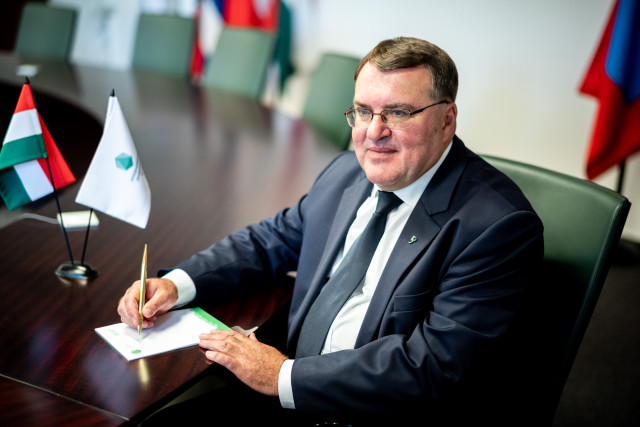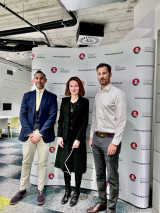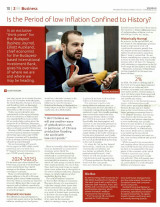Imre Laszlóczki, Deputy Chairperson of the International Investment Bank’s Management Board, gave an interview to Regiszter programme on Karc FM (Hungary)
Source: KarcFM
The guest of Regiszter programme on Karc FM was Imre Laszlóczki, Deputy Chairperson of the International Investment Bank’s Management Board, in charge of strategy and policy. Anita Kovács conducted the interview.
Regiszter: where the numbers and trends start to make sense.
Coming up: 30 minutes of fast economic analysis at Karc FM, with Anita Kovács.
Anita Kovács:
About 1.5-2 years ago, when International Investment Bank, the former bank of the Council for Mutual Economic Assistance (Comecon) relocated its headquarters to Hungary, the bank received a lot of press coverage. It was not always kind. The mere fact that it was supported by the Hungarian Government stirred controversy. Naturally, the opposition attacked it immediately and suspected all kinds of things behind the bank. Even as recently as this spring, they called International Investment Bank a mysterious bank. And recently, we received news that Slovakia is contributing to the paid-in capital of the Budapest-based International Investment Bank. So let’s start with this news, and we’ll learn about the details from Mr. Imre Laszlóczki, the Deputy Chairman of International Investment Bank’s Management Board, in charge of strategy and policy. Welcome, Sir!
Imre Laszlóczki:
Thank you, Anita, and warm greetings to the listeners as well. Thank you very much for the opportunity and for these questions. You are very observant; this Slovakian payment was indeed a sort of milestone for the bank. Regarding the negative news however, I would like to argue with you a little bit, because we had statistics drawn up towards the end of last year, as well as this year, and more than 90% of the news published about the bank was either positive or neutral. Terms that could be considered negative appeared only sporadically. So, we are satisfied with the reputation of the bank and with the news that has been published about the bank.
Anita Kovács:
Yes, I was talking about the news that came out two years ago, not recent news. But anyhow, it’s a fact that this is the first financial institution of its kind in this region. This gives a lot of weight to this financial institution. But please, tell us, who do you actually lend money to? Because you cannot just walk into International Investment Bank to borrow money. Who are your customers?
Imre Laszlóczki:
This isn’t exactly true, either, that you cannot walk in from the street, because we are happy to lend to bankable projects; to use banking jargon. So, if the situation arises, a serious company that wants financing from us may even walk in from the street; they just need to make a call and get in touch with our front office staff. You are perfectly right about the fact that this is a unique institution, as this is the only bank of this type in Central and Eastern Europe. This is an international bank that has been founded by and is run by nine member states. The majority of the international financial institutions that are the most similar or comparable to us are much larger than us. The most well-known among these are the EBRD and the EIB, the European Bank for Reconstruction and Development and the European Investment Bank. These may be better known to the Hungarian public, as they operate on a much large scale. But this does not bother us, we find our own market niches. So, there is a certain project size that does not engage these grandpas and grandmas, as we call them, but we get by excellently, and the vast majority of our member states need these smaller projects that can be financed by us. This means that the average size of our projects is 25-30 million euros. The larger banks that I mentioned prefer investments in the order of hundreds of millions.
Anita Kovács:
Who are your clients? Is it primarily governments, international companies, or countries joined together?
Imre Laszlóczki:
Companies, corporations. And as our shareholders are states, we primarily finance the companies and corporations of our member states. We prefer projects that strengthen so-called integration efforts. For example, when one of our member state’s corporation wishes to invest in a corporation of another member state – these are the kind of projects we like the most. So, this is what we like to invest in: projects that stimulate and facilitate cooperation between the countries, and that strengthen the economic cooperation between our member states.
Anita Kovács:
Hungary is definitely a member, as it provides the headquarters of the bank. Russia is also a member, and so is Slovakia, as we have recently learnt. Who are the other member states that are also founders?
Imre Laszlóczki:
The current member states are the same as the founder states, apart from a few member states. At the moment, we have nine member states, five of which are EU member states or NATO member states. These are Hungary, the Czech Republic, Slovakia, Bulgaria and Romania. Our largest shareholder is Russia, and for historical reasons, we also have three shareholders form outside of Europe: Mongolia, Vietnam and Cuba. So we describe the bank as the bank of nine countries and three continents. This has been shaped partially by historical factors. As you mentioned in the introduction, indeed, this bank used to be a Comecon bank. We are proud that our bank celebrated its 50th birthday this year. It was registered in the UN as an international organisation in 1970. However, there is a substantial difference between the history of the bank before 2012, and its history after 2012. In 2012, the leadership of the bank was handed over to a management team whose goal has been getting rid of the questionable heritage of the bank, and founding a modern, transparent, prudent international development institution. And the story of the past eight years has been a real success story: our capital and our loan portfolio have grown continuously, funding costs have decreased, and the number of projects financed by us has increased continuously. This is reflected in the ratings of the international rating agencies as well, because we are proud to say today that International Investment Bank has been given an “A” rating by the three most prominent, global Rating agencies. To put it simply, we have been welcomed into the elite club of international financial organisations.
Anita Kovács:
Could you mention a few projects you have financed that may be known by the public? Maybe from Hungary, something that is closer to us.
Imre Laszlóczki:
We have had approximately 100 large investment projects since 2012, the total volume of which has been 2.3 billion euros. As you certainly know, Hungary quit this bank in 2000, and rejoined in 2015. And since 2015, we have been consistently growing the Hungarian portfolio, and this year, even among the difficult circumstances of the pandemic, we have managed to considerably extend the Hungarian portfolio. For example, we have our Hunent Zrt. investment, which has been covered in the press: it’s a food industry project, the facilitation of the export of waterfowl. The Hungarian press have covered this thoroughly, so I won’t get into the details. What matters is that the Hungarian portfolio wasn’t even 8% when the bank relocated its headquarters to Hungary, and in the past year, we have managed to expand it to 12%. The current Hungarian share of paid-in capital is slightly above 17%. There is no such thing as an ideal situation, but we would like to bring these two numbers closer to each other: 8, which is now 12, to 17. It will of course take another few years to reduce the difference between the invested capital and the Hungarian projects financed by the bank, but we are on the right path. And I am happy to announce that currently, today, the value of the investments in the Hungarian portfolio is 125 million. There is another 135 million in the pipeline, which means the projects that have been approved but are not yet public. And there are projects worth another 110 million under assessment. And if you compare this to the paid-in capital, which is about 60-65 million, it becomes obvious that this is a good investment for the Hungarian government. Because for our 60-65 million paid-in capital, the bank is able to effectuate investments of hundreds of millions in the Hungarian economy. Until now the bank has supported Hungary with over 300 million, but a few projects have already been closed. The figures I’ve just mentioned refer to the new ones. For example, we have invested in the Hungarian tourism industry, which news became public yesterday. We are a partial investor of the BalaLand project in Szántód, recently we were there at the groundbreaking ceremony. Nice photosof the event can be viewed on the internet, in Magyar Építők Lapja (the Journal of the Hungarian Construction Industry).
Anita Kovács:
Have you at all been discouraged by the pandemic? Or do you see it as a temporary phenomenon?
Imre Laszlóczki:
The effect of the pandemic on our bank, however collateral, has been positive because many countries, including our member states have realised that these development banks are needed. Although there is quite a lot of money in Europe, the banks like us are still needed. Banks have their role, because development banks (including IIB) have a higher willingness to take risks. Plus we don’t have the kind of high pressure for profit that commercial banks have, and we are able to provide loans with longer maturities. The bottom line is, in tougher economic periods such as the current one, states are beginning to realise that international development banks are very useful, and we are enjoying the advantages of this right now. This means that we get an increasing amount of requests; not only from Hungary, but everywhere else as well.
Anita Kovács:
As for the Slovakian payment: it is nearly 3 million euros, Slovakia has contributed to the paid-in capital with a sum only a few hundred thousand euros short of 3 million euros. Is this a continual contribution, or a one-time payment? And also, what is the capital stock of the bank like?
Imre Laszlóczki:
There are different types of capital, but the so-called paid-in capital, which is provided to the bank by the member states free of charge, so to speak. The current amount of the paid-in capital by all member states is 374 million. This now includes the Slovakian three million. This is what has been historically accumulated, paid in by the member states. It should be noted that a new strategy was adopted in 2018, and as part of it, the Governors of the bank, who are the ministers of finance and the heads of the national banks of the given member states, have accepted a so-called new capitalisation or recapitalisation programme in the value of 200 million euros. This is aimed at ensuring the continued development of the bank. We have distributed these 200 million euros over the period between 2020 and 2022 on a so-called pro rata basis, meaning that whatever share ratio member states had of the paid-in capital will be the same share they will have of this 200 million, so they have the opportunity to pay it. This new capitalisation or recapitalisation programme was approved by the member states in 2018. And accordingly, the payments started in 2020. Russia, the largest shareholder, has done its part, so did Hungary, the host country of the Bank, and as the news has reported, Slovakia was the third to pay its part for 2020. We have received news that the majority of the member states will pay their part for 2020, not to mention that they can also pay their part of the 200 million in 2021-22, pro rata temporise, in staggered payments. So, Slovakia has simply fulfilled its obligation. Yet, even if it may seem like a small amount compared to the 200 million, it is a big deal, because when a member state expresses its support for the bank through a so-called capital contribution like this, it is appreciated substantially by the international rating agencies that we have mentioned previously.
Anita Kovács:
You have also issued bonds for institutional investors. That, in effect, also increases your margin of financial leeway.
Imre Laszlóczki:
That is the essence of our operation as a bank and the bonds issued form the basis of our investments.
Anita Kovács:
So, this is what you provide the loans from?
Imre Laszlóczki:
Exactly. Not from the paid-in capital, as that’s the smaller part. However, we cannot increase our loan portfolio to an unlimited extent, if the paid-in capital does not also increase proportionately. Once we are on the topic of bonds, it is worth mentioning that the number of our investors has grown continuously throughout the past years. Currently we have 180 institutional investors; approximately 70% of them are from Europe.
Anita Kovács:
So they are those who have purchased your bonds.
Imre Laszlóczki:
Yes, who have purchased our bonds. Another important factor related to bond issue is that with these bond issues we are also able to contribute to the development of the financial markets of our member states. Because there are very few, or rather, there is no other international financial institution apart from us that frequently issues bonds in Romanian leu, Czech koruna or Hungarian forint. But we do it, our bonds are very popular, and oversubscription is constant. Recently we have issued bonds in Romania in the value of approximately 60 million euros (with incredible oversubscription), with the lowest cost there’s ever been. At a price of less than 0.4%.
Anita Kovács:
If paid-in capital is so fundamental and essential for you, as for any other financial institution, why don’t you urge the other member states to fulfill their payment obligations? Because, in this sense, the volume of your lending activities could also grow.
Imre Laszlóczki:
There’s no need to urge them, because they have approved it. They have voted in favour of it, they have accepted it. And right now, due to the pandemic situation, the member states may have some difficulties, because... The point is, no fixed deadline has been set for the payments. They need to pay between 2020 and 2022, in three years, but in varying amounts. Some pay in equal instalments, and some will start only in 2021... The different countries have different liabilities. It is the member states that can assess their own financial situations... So, this is why this Slovakian payment is so important, because it shows what Slovakia thinks. By the way, this amount, which they paid, was what they undertook for 2020. So, Slovakia has undertaken to pay this amount of nearly 3 million in 2020, and they have just fulfilled their obligation. At the same time, there is always a chance that not all member states will be able to fulfill their commitments. If that occurs however - then next year, and in 2022, they will pay a little bit more. But that is still good enough, because the strategy and the capitalisation programme will be fulfilled.
Anita Kovács:
From among the Visegrád Group, Poland is the only country that is not a member of International Investment Bank, even though there are projects that have been very much in the spotlight recently. There is more and more talk of the fact that the road and railway network connecting Warsaw to Budapest, Bratislava, and Prague is on the agenda. And this, I believe, could be a good investment opportunity for International Investment Bank. I wonder if you have thought about this, if you have had any negotiations, or if the fact that Poland is not a member state could impede an investment like this?
Imre Laszlóczki:
Let us separate the question into two parts. It’s a very good question, but let us separate it. So, in order for a project involving four countries to be realised, it is enough for us if at least one of our member states participates in it. So, if these three current member states, that is, the Czech Republic, Slovakia, and Hungary are included in the project, and so is Poland, the project can still be carried out. Poland not being a member does not impede the implementation of the project. The other part of the question: why Poland is not a member, and whether it will be at some point, I think it’s better to address this question to Poland. I think that they are watching us closely, they can see the achievements of the bank. Given that the people in national governments usually know what they are doing, Poland must be thinking about having some kind of role in the bank.
Anita Kovács:
What do you think, when will International Investment Bank reach its optimal size? That is, in the near or medium-term future, what do you envision for the bank?
Imre Laszlóczki:
In the strategy I mentioned previously, which is for the period up till 2022, we have set a target of 1.7 billion euros for our so-called loan and documentary portfolio. It’s already clear that we will reach this very easily. If our loan portfolio keeps growing at the same pace, in the same way, if the completion of the capitalisation programme continues the same way, we will easily reach our strategic target. On the other hand, we don’t want to grow too fast, either, because that would raise further issues. So, as I said, we will unquestionably, definitely reach the strategic target we have set. But I am not sure if we would like to surpass it, as that would create the need for further decisions to be made, and the member states have to want to contribute to the faster growth of the bank unanimously. And that would create the need for a whole lot of complementary decisions to be made. There is definitely potential for even faster growth in the bank, in the management itself, in the experts, but that would bring up a great deal of further questions to be considered. So, the bank has a three-level management structure. There is the Management board, which I am a member of. There is the so-called Board of directors, who meet four-five times a year. And there is the highest decision making body, the so-called Board of Governors, who meet once a year; and this year they are yet to meet. Our hope is that they can meet in December, and then we will present our medium-term assessment of the bank’s growth to the shareholders and to the highest decision makers of the shareholders. And there is a possibility that the governors decide that the bank may grow faster. But I would rather not presume this, because, honestly, they will note with satisfaction that everything is going according to plan, and that we will undoubtedly reach our target set for 2022. If the shareholders instruct us to grow faster, we will of course be able to meet these expectations.
The guest of Regiszter was Imre Laszlóczki, Deputy Chairperson of the International Investment Bank’s Management Board, in charge of strategy and policy, to discuss the recent development that the Slovak Republic contributed nearly 3 million euros to the paid-in capital of the bank, and has expanded the scope of its lending activities proportionately. We have heard about the plans and realised investments of the bank, its developments, and about the financial institution based in Budapest. Again, thank you very much, Mr. Laszlóczki, for all the information.


